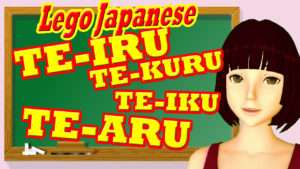 Te iru, te aru, te iku and te kuru are among the most commonly used constructions in Japanese.
Te iru, te aru, te iku and te kuru are among the most commonly used constructions in Japanese.
Once you’ve learned how to make and recognize the te-form (made super easy in our last video lesson) you’ll want to start using it. It isn’t difficult and the textbooks don’t do a bad job of teaching it.
But…
They do tend to omit telling you the rationale behind how it all works, and that makes life harder.
Why do they do it? In this case I think it’s because they don’t want to burden students with “something extra to learn” – but that something is what makes it all hang logically together.
So it’s a bit like making people carry the shopping home without a bag because the bag would be “something extra to carry”.
Yes it would – but it’s the something that makes carrying the rest easier!
It’s not a huge deal in this case (the way it is in some of the grammar taught in this series) but if you know, for example why te iru (meaning “be”) is used the way it is, and what is the logic behind using te aru in place of te iru, it makes it a lot easier to know what you are doing instinctively rather than just trying to remember abstract “rules”.
More importantly, by learning it logically and organically we start to get a grasp of the way Japanese, unlike Western languages, fits together in various ways like so many very regular, very logical lego-blocks.
So let’s devote 8 minutes to learning just how te iru, te aru, te iku and te kuru really work!
Notes:
1. One other irregularity (apart from kuru and suru) is iku which is irregular in te-form only (it is itte instead of iite). This really is the only other irregularity you will encounter in basic Japanese.
2. Why do we say akete aru when we say aite iru? This is because logically te aru can only be used with transitive verbs while te iru can be used with both intransitive and transitive ones (but tends to favor intransitive).
Our article on transitive and intransitive verbs makes this much easier. But if you’re a beginner don’t worry about it too much yet. All you need to know is that 開く means open (as in “the door is open) while 開ける means opening something (as in “I opened the door”).
Te aru needs a transitive verb because it is always stressing that somebody caused the state something is in. Te iru doesn’t and is happy with either. If this is all gobbledegook to you, don’t worry. You’ll get to it as your Japanese level advances.